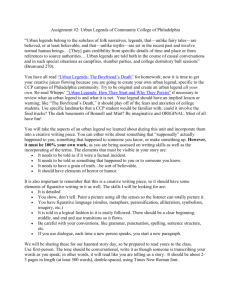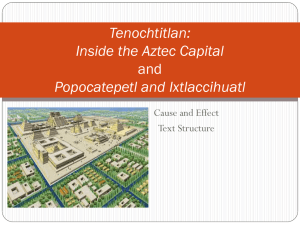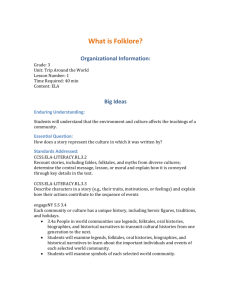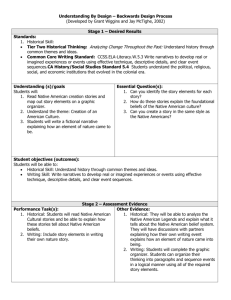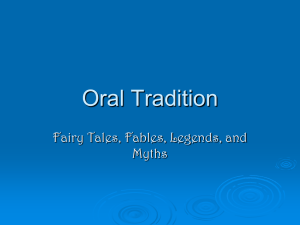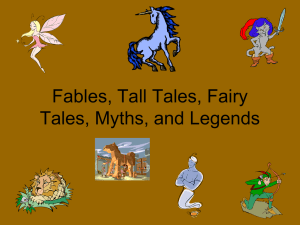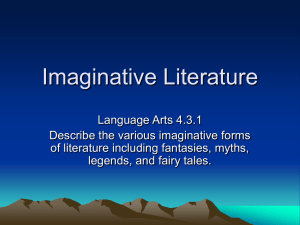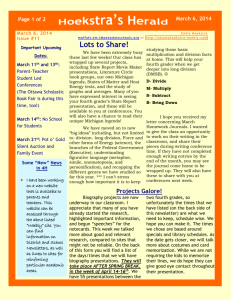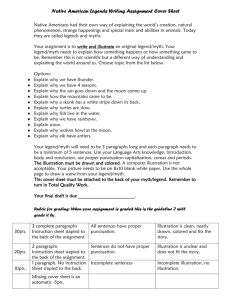Unit Plan: Sentence Fluency/ Legends and Geography Grade: 8 Unit
advertisement
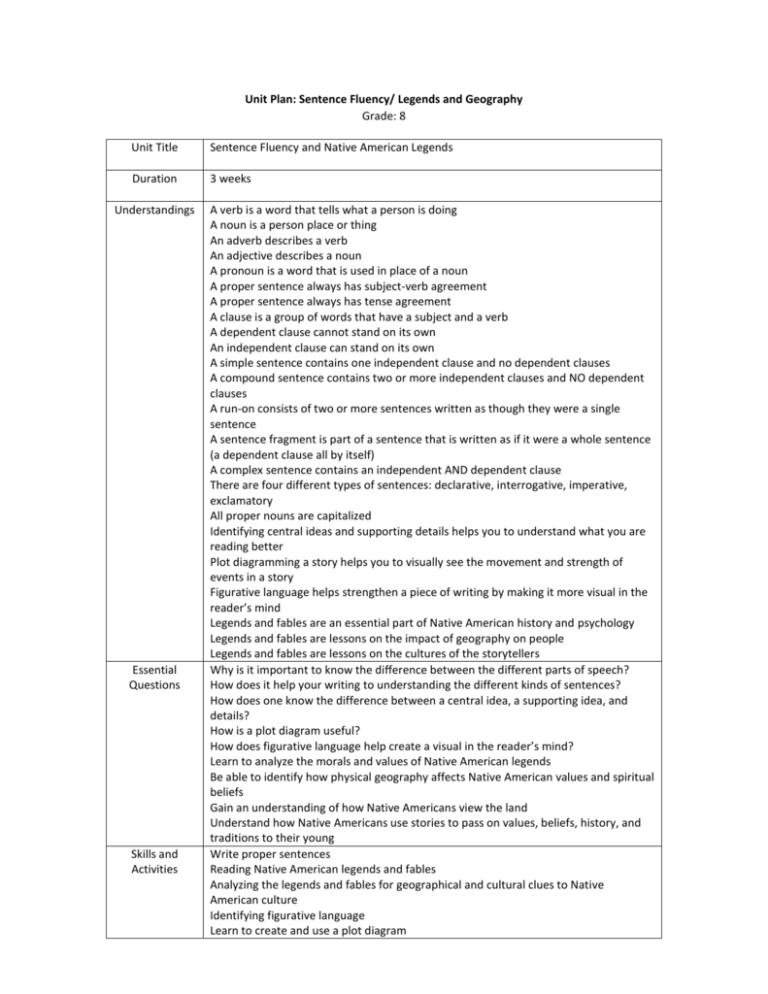
Unit Plan: Sentence Fluency/ Legends and Geography Grade: 8 Unit Title Sentence Fluency and Native American Legends Duration 3 weeks Understandings Essential Questions Skills and Activities A verb is a word that tells what a person is doing A noun is a person place or thing An adverb describes a verb An adjective describes a noun A pronoun is a word that is used in place of a noun A proper sentence always has subject-verb agreement A proper sentence always has tense agreement A clause is a group of words that have a subject and a verb A dependent clause cannot stand on its own An independent clause can stand on its own A simple sentence contains one independent clause and no dependent clauses A compound sentence contains two or more independent clauses and NO dependent clauses A run-on consists of two or more sentences written as though they were a single sentence A sentence fragment is part of a sentence that is written as if it were a whole sentence (a dependent clause all by itself) A complex sentence contains an independent AND dependent clause There are four different types of sentences: declarative, interrogative, imperative, exclamatory All proper nouns are capitalized Identifying central ideas and supporting details helps you to understand what you are reading better Plot diagramming a story helps you to visually see the movement and strength of events in a story Figurative language helps strengthen a piece of writing by making it more visual in the reader’s mind Legends and fables are an essential part of Native American history and psychology Legends and fables are lessons on the impact of geography on people Legends and fables are lessons on the cultures of the storytellers Why is it important to know the difference between the different parts of speech? How does it help your writing to understanding the different kinds of sentences? How does one know the difference between a central idea, a supporting idea, and details? How is a plot diagram useful? How does figurative language help create a visual in the reader’s mind? Learn to analyze the morals and values of Native American legends Be able to identify how physical geography affects Native American values and spiritual beliefs Gain an understanding of how Native Americans view the land Understand how Native Americans use stories to pass on values, beliefs, history, and traditions to their young Write proper sentences Reading Native American legends and fables Analyzing the legends and fables for geographical and cultural clues to Native American culture Identifying figurative language Learn to create and use a plot diagram Acquire and learn to use new vocabulary related to the Native American legends Become more confident in performing in front of a group (voice/volume/expression etc) Learn to identify themes/central ideas, movement of plot, figurative language etc Pre Unit Assessment Formative Assessment Summative Assessment Standards and Benchmarks Resources Sentence practice Reading discussions of legends Analyzing worksheets Written test on the sentence portion of unit Oral and written exam on the legend and fable portion of unit Aero standards for Language Arts 6-8: RL 2, 3, 4 Native American legend websites o http://www.firstpeople.us/FP-Html-Legends/Legends-AB.html o http://www.indigenouspeople.net/stories.htm o http://americanfolklore.net/folklore/native-american-myths/ o http://www.native-languages.org/legends.htm o http://www.firstpeople.us/FP-Html-Legends/Legends-AB.html Literature Anthology textbook (brown) Native American Stories – Joseph Burchach http://www.youtube.com/watch?v=SlHtzU133NI (also a downloaded video in the unit file) Attachments (Reflection) Lesson Blocks *Students should take notes throughout this lesson Lesson 1: Parts of speech review 1. Put the 6 different parts of speech on the board (noun, verb, adverb, adjective, pronoun, proper noun, propositions and conjunctions) and have students come up and write appropriate words under each heading – review for accuracy a. Focus on adverbs: end in “ly” b. Green book pages, nounts: 36/ pronouns: 59, / verbs: 92, / adj:126 / adv: 134/ propositions: 152, / conjunctions:158 Lesson 2: Sentences 1. Review the parts of a sentence: subject verb object: a. Green book: 186 2. Review the different types of sentences a. See SENTENCE LESSON (BELOW) b. Do exercises in green book187, 190, 191, 193, (198, 199 compound complex lesson) 3. Review kinds of sentences (dec, int. etc) a. Do the exercise on page 17 of green book for practice – 17 4. Review the different tenses – practice conjugating Lesson 3: REVIEW Graphic organizers 1. PPT of different types of GOs a. Styles b. Uses 2. Lesson on main idea/supporting idea/details/supporting details a. Format example b. Types of fruit example 3. Have them make a GO using main ideas etc as the theme with the grammar lessons they’ve been learning 4. FOCUS: Concept maps a. Create a concept map of teachers at AISB (some work elementary and secondary, some work in admin and teaching) – show the various relationships 5. FOCUS: Outlines 6. Show how Prezi works 7. Show how to make GOs on the computer 8. Show how to make outlines on the computer Lesson 4: Paper test on sentence fluency Lesson 5: Introductions and background 1. Lesson on what legends/fables/myths/creation/folklore stories are a. Show examples for each kind and point out elements of each kind i. Legend: http://www.firstpeople.us/FP-Html-Legends/Legends-AB.html ii. Creation/Myth: http://www.indigenouspeople.net/stories.htm iii. Fable: Assops: http://www.aesopfables.com/aesop3.html b. Elements of each: Myth A myth is a traditional story, which may describe the origins of the world and/or of a people. A myth is an attempt to explain mysteries, supernatural events, and cultural traditions. Sometimes sacred in nature, a myth can involve gods or other creatures, and, a myth represents reality in dramatic ways. Folklore/Folktale Whereas myth has at its core the origins of a people, and is often sacred, folklore is a collection of fictional tales about people and/or animals. Folktales describe how the main character copes with the events of everyday life, and the tale may involve crisis or conflict. Superstitions and unfounded beliefs are important elements in the folklore tradition. The study of folklore is called folkloristics. Legend A legend is a story purported to be historical in nature, but without substantiation. Prominent examples include: King Arthur, Blackbeardand Robin Hood. Where evidence of the existence of actual historical figures exists, figures like King Richardare legends due in large part to the many stories that have been created about them. Legend also refers to anything that inspires a body of stories, or anything of lasting importance or fame. The story is handed down from earlier times, but will continue to evolve with time. Fables Very few characters; characters are animated or personified. Anywhere and time is real. Very simple and short plot, but thought provoking and interesting, and a fable always has a theme or moral message behind it. Fables tend to focus on human strengths or weaknesses. Lesson 6: Central ideas, plot diagramming and figurative language 1. Quick review lesson of central idea, supporting idea, detail, supporting detail, theme etc a. Choose a few stories and have students identify the above 2. Quick review on plot diagram a. Choose a few stories and have students create a plot diagram 3. Quick review of what figurative language is a. Choose a few stories and have students identify the figurative language used and how it enhanced the story Lesson 7: Legends and Geography 1. Read legends from the websites above and DISCUSS what the story tells you about how the people relate to the land AND what it tells you about how they live. 2. Discuss why Nature/the land was so important to them a. Got livelihood from it b. Spiritual connection c. All they knew d. Had a different view of nature’s purpose 3. Discuss how the land influenced how they lived and thought, and what they believed. a. Discuss what aspects of their culture was directly connected to the land Lesson 8: Written exam for legends and geography
